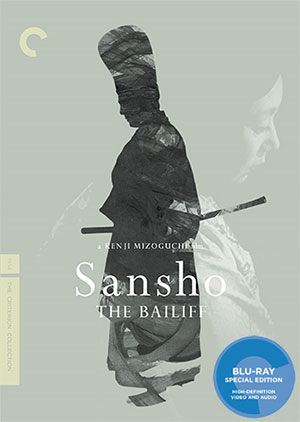Blu Review: Sansho The Bailiff (1954)
 Cast: Kinuyo Tanaka, Yoshiaki Hanayagi, Kyôko Kagawa
Cast: Kinuyo Tanaka, Yoshiaki Hanayagi, Kyôko Kagawa
Director: Kenji Mizoguchi
Country: Japan
Genre: Drama
Official Trailer: Here
Somewhere off-screen, flesh crackles and blisters. Liquefied on contact by fire-lit iron, the forehead skin of the slave first melts and gnarls before finally congealing into its new, permutated state. Now forever marked, the servant lives out his buffeted existence as a walking monolith, a human insignia, to the cost of defiance: Oppression, torture, and deformity of both mind and body alike.
Such transgressions are commonplace in the world of Sansho the Bailiff, a world of feudally derived asymmetry and violent displays of power. Encapsulating the absurdity of not only inhumanity but also birthright privilege – notions director Kenji Mizoguchi employs to reveal concerns of class-and-gender based subjugation – the work deliberately takes the shape of an aphotic folk tale, leaning on its ties to oral tradition as a way to impress a certain timeless relevance on the subject matter. Its narrative built upon an amaranthine parable, the film cleverly floats through time and space in its renouncement of apathy, in its quest to show the pains of sweeping, systematic transition. To place the piece within a historical context is to acknowledge its proximity to the Second World War, which in turn is to acknowledge Japan’s own shifts toward democratic tendency. But Sansho the Bailiff remains more broadly allegorical than pointedly political, more tenderly attune to interpersonal demands than those of a shifting zeitgeist. Like fables of old, Mizoguchi crafts his tale in a delicate, classical manner, carefully braiding tragedies into an, albeit weighty, chiffon chimera.
Its narrative built upon an amaranthine parable, the film cleverly floats through time and space in its renouncement of apathy, in its quest to show the pains of sweeping, systematic transition.
 Toward the film’s crushing denouement, mortal life is described as a but transient existence – a statement more akin to a collective outlook on earthly torments than it is of any portended gifts to be found in death. Suffering abounds in Sansho the Bailiff, and the physical afflictions of Mizoguchi’s vision are considerably juxtaposed against the humanistic tenor of its lead family. Evinced first through a flashback, the maxim spoken by the father of leads Zushio (Yoshiaki Hanayagi) and Anju (Kyôko Kagawa) eventually takes the form of ethereal, echoic being: “Without mercy, man is like a beast. Men are created equal. No one should be denied happiness.” This iterance, coalesced with the introductory text assigning the story to a time when “People were not yet human beings,” evokes a vein of savagery still coursing through our blood line, an underlying carnality that must be overtaken. Such dictums cast a critical eye on our distorted sense of civility, bringing forth the notion of how the accomplishments of our species stem from the subversion, the conquering of our most fundamental drives. Thus, any featured acts of malice – which generally come in the form of clinically sadistic reprimands – not only disavow compassion but, what’s more, ignore the unique understanding of unity that our world is built upon. Simply, to malign the face of a slave is to slight the oneness of all.
Toward the film’s crushing denouement, mortal life is described as a but transient existence – a statement more akin to a collective outlook on earthly torments than it is of any portended gifts to be found in death. Suffering abounds in Sansho the Bailiff, and the physical afflictions of Mizoguchi’s vision are considerably juxtaposed against the humanistic tenor of its lead family. Evinced first through a flashback, the maxim spoken by the father of leads Zushio (Yoshiaki Hanayagi) and Anju (Kyôko Kagawa) eventually takes the form of ethereal, echoic being: “Without mercy, man is like a beast. Men are created equal. No one should be denied happiness.” This iterance, coalesced with the introductory text assigning the story to a time when “People were not yet human beings,” evokes a vein of savagery still coursing through our blood line, an underlying carnality that must be overtaken. Such dictums cast a critical eye on our distorted sense of civility, bringing forth the notion of how the accomplishments of our species stem from the subversion, the conquering of our most fundamental drives. Thus, any featured acts of malice – which generally come in the form of clinically sadistic reprimands – not only disavow compassion but, what’s more, ignore the unique understanding of unity that our world is built upon. Simply, to malign the face of a slave is to slight the oneness of all.
Further enriching the picture’s hereditary and humanistic ken are numerous cases of items and ideologies being passed unto others, exemplars of memetic culture flourishing like genes in traditional charts of lineage. Throughout the proceedings, Zushio and Anju come to be molded by observable, proximal stimuli: The former surrenders to his surrounding pestilence (“He must be the son of a bandit,” a peripheral character quips) while the latter retains her inborn bearings of grace and amity. This bifurcation of the sibling’s attitudes is one of worthy study, for it not only shows the combativeness inherent to our daily decisions but also comments on gender-based behavioral disparities. Something of a feminist – it’s rumored this attitude is one of atonement for difficulties he afforded the fairer sex as a youth – Mizoguchi typically, though not always, ascribes his female characters with a grandcapacity for tenderness; in turn, women then gift their hormonally posturing counterparts something of a more unifying social perspective.
This bifurcation of the sibling’s attitudes is one of worthy study, for it not only shows the combativeness inherent to our daily decisions but also comments on gender-based behavioral disparities.
 But the broadest threads of this celluloid tapestry are ultimately its most rewarding, and Sansho the Bailiff will be first remembered for its septic depictions of feudalism and hierarchy alike. A deceivingly complex sea of connectivity, Mizoguchi’s heralded work is one saturated with, and perhaps even defined by, contrast: The push/pull dialogue of our natural bents, to be sure, but also the dynamics of oppressor/oppressed relationships, and the fragile sheath separating feelings of betrayal from trust. How the titular despot is rewarded for his savage hand by his own higher-ups (“One must obey his superior officer”) is critical of the systemic flaws associated with governance; that the focal family’s patriarch is exiled due to his own propensity for kindness is a further indictment of ruling priority. Sansho the Bailiff is a work that demonstrates an artist’s apprehension for not only the ubiquity of interpersonal toxicity in our world but also the actions that nurture its growth: complicity of the privileged class, the perceivable futility of revolutionary efforts, and a learned sense detachment from those with whom we exist. Though its elicitations can border on the melodramatic, its flourishes more on the gesticulative than nuanced, Mizoguchi’s film triumphs by way of its wholeness of vision and transcendence of specific context – ostensibly manageable, timeless storytelling.
But the broadest threads of this celluloid tapestry are ultimately its most rewarding, and Sansho the Bailiff will be first remembered for its septic depictions of feudalism and hierarchy alike. A deceivingly complex sea of connectivity, Mizoguchi’s heralded work is one saturated with, and perhaps even defined by, contrast: The push/pull dialogue of our natural bents, to be sure, but also the dynamics of oppressor/oppressed relationships, and the fragile sheath separating feelings of betrayal from trust. How the titular despot is rewarded for his savage hand by his own higher-ups (“One must obey his superior officer”) is critical of the systemic flaws associated with governance; that the focal family’s patriarch is exiled due to his own propensity for kindness is a further indictment of ruling priority. Sansho the Bailiff is a work that demonstrates an artist’s apprehension for not only the ubiquity of interpersonal toxicity in our world but also the actions that nurture its growth: complicity of the privileged class, the perceivable futility of revolutionary efforts, and a learned sense detachment from those with whom we exist. Though its elicitations can border on the melodramatic, its flourishes more on the gesticulative than nuanced, Mizoguchi’s film triumphs by way of its wholeness of vision and transcendence of specific context – ostensibly manageable, timeless storytelling.
Extras
As expected from Criterion, Sansho the Bailiff looks fittingly resplendent on Blu-ray, and the transformative care it’s afforded brings an eerie, aproposstability to its audio/visual presentation. Because the film is not one of high visceral agency, the image quality is imbued with a sturdy yet aerial quality that, despite not being allotted a particular amount of depth, instills the picture with dreamlike, lucid clarity. The linear PCM audio track isn’t exactly robust, but it tidily encapsulates the aural design of the filmmaker’s intent.
Accompanying supplemental material appears to be carried over from Criterion’s initial DVD release, and exceeds in augmenting Mizoguchi’s deft human touch. The running commentary of Japanese literature scholar Jeffrey Angles captures this quintessence without airs of pretension or didacticism, and the triad of video interviews, individually taken, each add distinct perspective to the work’s thematic and formal breadth. And as usual, the attention given to packaging, not to mention the written words of its booklet make this release something to cherish, even if it is a work defined by sorrow and devastation.
-
http://www.facebook.com/people/Chris-D-Misch/28134555 Chris D. Misch
-
http://www.facebook.com/joe.galm Joe Galm






















 Blu Review: Badlands (1973)
Blu Review: Badlands (1973) Review: Room 237 (2012)
Review: Room 237 (2012) SXSW Review: A Teacher (2013)
SXSW Review: A Teacher (2013) Review: The Incredible Burt Wonderstone (2013)
Review: The Incredible Burt Wonderstone (2013) Review: Spring Breakers (2012)
Review: Spring Breakers (2012)



